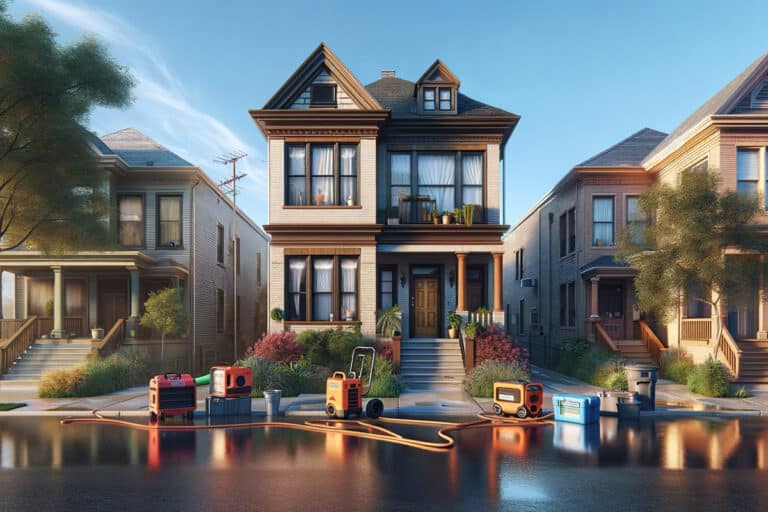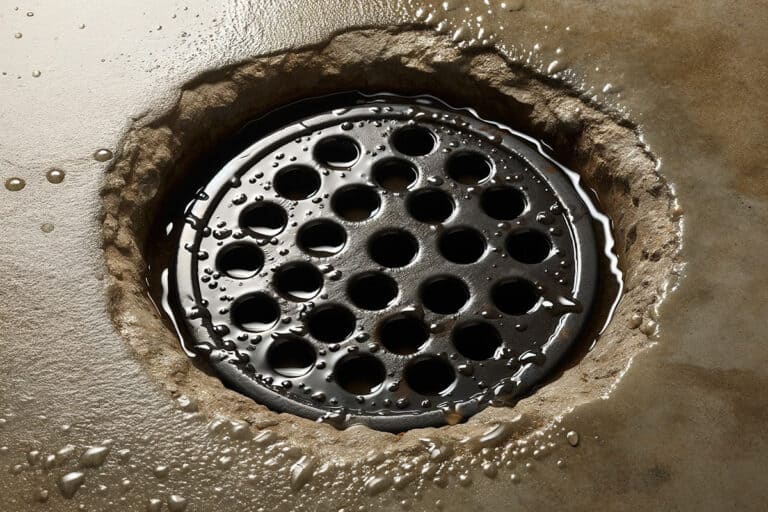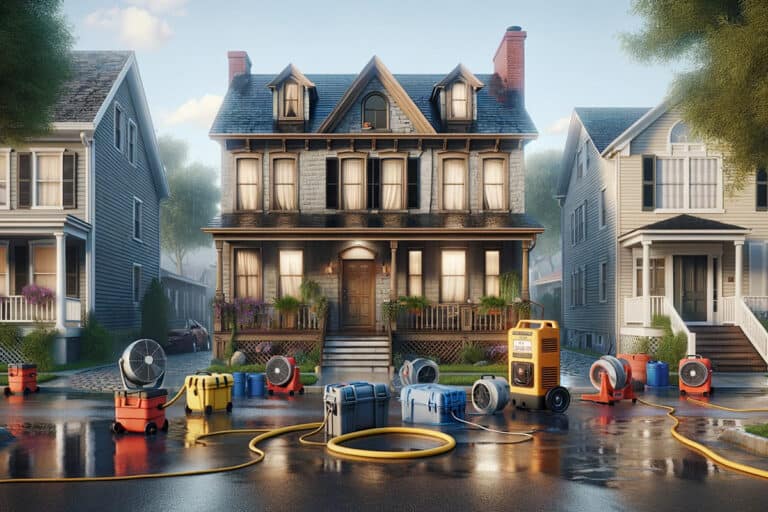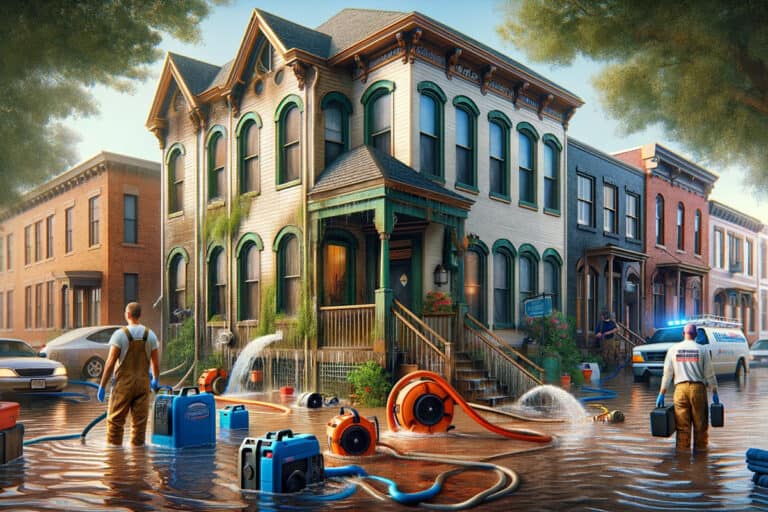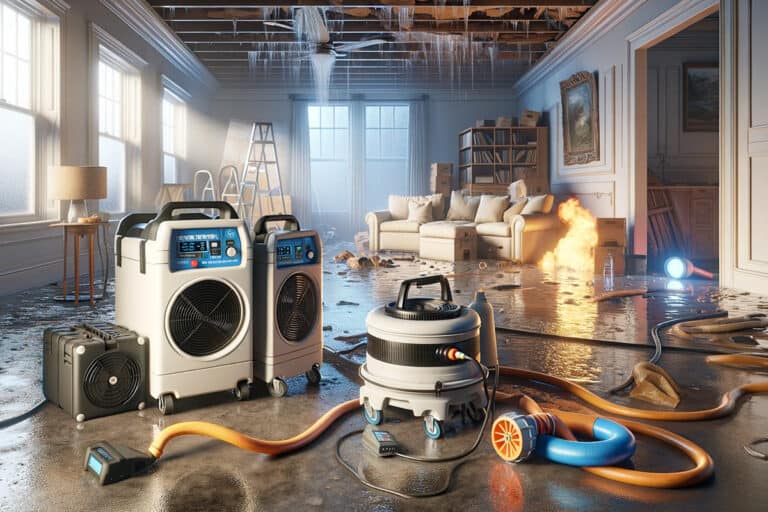Disclosure: I am compensated for purchases made through some links on this site. Click for details.
Water damage can be a homeowner’s worst nightmare. Whether it’s a burst pipe, a flood, or a leaky roof, the intrusion of water can cause immense damage to your property and possessions. The process of restoring your home to its pre-damage state is known as water damage restoration.
This comprehensive guide will walk you through what water damage restoration entails, the types of water damage you might encounter, the steps for restoration, cost considerations, and how to prevent future water damage.
What is Water Damage Restoration?
Water damage restoration is the process of cleaning up and repairing any damage caused by water. This means not only removing the water itself but also sanitizing the affected areas, preventing mold growth, and repairing or replacing damaged structures or items. The goal is to restore your property to its original, livable condition.
What Causes Water Damage?
Water damage can arise from various sources, often when you least expect it. Common culprits include:
- Natural Disasters: Heavy rains, flooding, and hurricanes can lead to significant water intrusion.
- Plumbing Issues: Burst pipes, leaky faucets, and sewage backups are frequent offenders.
- Appliance Failures: Dishwasher leaks, washing machine overflows, and water heater ruptures can all result in water damage.
- Structural Problems: Poorly sealed windows, damaged roofing, and foundation cracks can allow water to enter your home.
Understanding these common causes can help you stay vigilant and take preventative measures to protect your property.
Types of Water Damage
Water damage is not a one-size-fits-all problem. It comes in various forms, each with its own set of challenges and safety concerns. Broadly categorized into three types—Clean Water, Grey Water, and Black Water—understanding these distinctions is crucial for proper treatment and restoration. Here’s a closer look at each type of water damage:
Clean Water (Category 1)
Clean Water damage is the least harmful type since it involves water that does not contain harmful contaminants. This type of water typically originates from:
- Broken water supply lines
- Overflowing sinks or bathtubs without contaminants
- Appliance malfunctions involving water supply lines
- Rainwater or melting snow that has not come into contact with harmful substances
Though not immediately dangerous to health, clean water can escalate to more serious categories if not addressed quickly, as standing water can become a breeding ground for pathogens.
Grey Water (Category 2)
Grey Water damage involves water that has been used and may contain contaminants that could cause illness or discomfort if ingested. This type of water can come from:
- Dishwasher or washing machine overflow
- Water from sinks and tubs containing traces of food, grease, or household cleaning agents
- Toilet overflow with urine (but not feces)
- Sump pump failures
- Seepage due to hydrostatic failure
With grey water, the urgency for cleanup is greater due to the elevated risk of bacteria and mold growth, which can lead to more significant health risks and property damage. It requires a more thorough cleaning due to its potential to harbor harmful microorganisms.
Black Water (Category 3)
Black Water damage is the most dangerous type of water damage. It is grossly contaminated and can contain harmful bacteria, fungi, and toxic agents that pose serious health risks. Common sources are:
- Sewage backups
- Floodwaters from rivers or streams
- Standing water that has begun to support microbial growth
- Water from beyond the toilet trap
- Any water containing chemical or biological contaminants
Due to the toxic nature of black water, it requires immediate and specialized remediation efforts to ensure that affected areas are thoroughly sanitized and safe for occupancy.
To help distinguish between these types of water damage, here’s a table that outlines their sources, risks, and necessary actions for remediation:
Table 1: Types of Water Damage: Sources, Risks, and Remediation Actions
| Type of Water Damage | Sources | Potential Risks | Recommended Actions |
|---|---|---|---|
| Clean Water | Broken pipes, Overflowing sinks, Appliance leaks | Deterioration of materials, Mold growth if untreated | Prompt removal and drying, Monitor for contamination |
| Grey Water | Dishwasher overflow, Washing machine discharge, Sump pump failure | Bacteria, Mold, Mildew | Immediate removal, Disinfecting, Avoid direct contact |
| Black Water | Sewage backup, Floodwaters, Standing water | Pathogens, Toxins, Serious health risks | Professional remediation, Full PPE, Structural assessment |
Regardless of the type of water damage, the key to effective water damage restoration is a swift response. The longer water remains in your property, the more opportunity there is for damage to set in and for clean water to escalate to grey or even black water as it comes into contact with contaminants.
When facing any category of water damage, it’s often best to consult with a professional water damage restoration service. They are equipped to safely handle the various complexities each type of water damage presents, ensuring that your property is properly cleaned, sanitized, and restored to a safe environment.
The Water Damage Restoration Process
The water damage restoration process is a structured approach to addressing and repairing the aftermath of a water incident. A successful restoration involves several crucial steps, each requiring specific tools and techniques to ensure that the property is thoroughly dried, cleaned, and restored. Below, we outline these steps, along with the equipment often used at each stage:
Emergency Contact
The first step in the water damage restoration process is to make an emergency contact to a professional service. Timing is critical, and the faster a team can respond, the better the chances of mitigating the damage.
Tools & Techniques:
- 24/7 Hotline: Most restoration companies offer an emergency line for immediate response.
- Mobile Apps: Some services may provide apps for quick reporting of damage.
Inspection and Damage Assessment
Upon arrival, the restoration team will inspect the property to assess the extent of the water damage. They’ll identify the water source, the type of water involved, and the areas affected.
Tools & Techniques:
- Moisture Detectors: Hygrometers and moisture detectors to measure moisture saturation.
- Infrared Cameras: To find hidden water behind walls and in ceilings.
Water Removal/Water Extraction
This step involves removing the bulk of the water from the property. It is crucial for preventing further damage and for reducing drying time.
Tools & Techniques:
- Submersible Pumps: For high-level water removal.
- Truck-mounted Vacuums: For efficient water extraction.
Drying and Dehumidification
After the water is removed, the property will still be wet. Drying and dehumidification are essential to remove the remaining moisture.
Tools & Techniques:
- Air Movers: To facilitate the quick drying of surfaces.
- Dehumidifiers: To remove airborne moisture and prevent mold.
Cleaning and Sanitizing
Once the area is dry, cleaning and sanitizing are necessary to prevent mold and mildew, as well as to remove any contaminants.
Tools & Techniques:
- Air Scrubbers: To remove particles and contaminants from the air.
- Antimicrobial Treatments: To disinfect and prevent bacterial growth.
Restoration
The final step is restoring your home or business to its pre-damage condition. This might involve minor repairs, such as replacing drywall and installing new carpet, or it could entail major repairs, such as the reconstruction of various areas or rooms in a home or business.
Tools & Techniques:
- Construction Tools: For repairs and rebuilding.
- Professional-Grade Paints and Sealers: To restore and protect surfaces.
Table 2: Tools and Techniques Used in Restoration
| Step | Tools/Equipment | Techniques |
|---|---|---|
| Water Removal/Extraction | Pumps, Vacuums | Removing standing water |
| Drying and Dehumidification | Air Movers, Dehumidifiers | Eliminating residual moisture |
| Cleaning and Sanitizing | Air Scrubbers, Antimicrobial Treatments | Disinfecting affected areas |
Table 3: Water Damage Restoration Process – Summarization of Tools and Techniques Used in each Step
| Restoration Step | Tools/Equipment | Techniques |
|---|---|---|
| Emergency Contact | 24/7 Hotline, Mobile Apps | Immediate response, Assessment scheduling |
| Inspection and Damage Assessment | Moisture Detectors, Infrared Cameras | Identifying damage extent, Categorizing water type |
| Water Removal/Extraction | Submersible Pumps, Truck-mounted Vacuums | Bulk water removal, Preventing secondary damage |
| Drying and Dehumidification | Air Movers, Dehumidifiers | Removing residual moisture, Preventing mold growth |
| Cleaning and Sanitizing | Air Scrubbers, Antimicrobial Treatments | Disinfecting, Odor removal, Sanitizing |
| Restoration | Construction Tools, Professional-Grade Paints | Repairs, Rebuilding, Final touches |
Each phase of the water damage restoration process is designed to move a property through the stages of emergency response, drying, and repair, with the ultimate goal of returning the property to its original state. It’s a meticulous process that requires expertise, the right tools, and a dedication to detail to ensure that every last trace of water damage is effectively addressed.
Cost Considerations in Water Damage Restoration
When facing water damage, one of the most pressing concerns for property owners is the cost of restoration. Several factors can influence the total cost, and understanding these can help you prepare for the financial aspect of the recovery process.
Factors Influencing the Cost
Several variables play a role in determining the cost of water damage restoration:
- Type of Water: As outlined previously, clean water damage is generally less expensive to deal with than grey water, with black water being the most costly due to the need for extensive sanitation and potential health hazards.
- Extent of Damage: The size of the affected area and the degree of damage significantly impact the cost. A small, contained area is less expensive to restore than an entire basement flood.
- Duration of Exposure: The longer water sits, the more damage it causes, leading to higher restoration costs.
- Location of Damage: Damage in hard-to-reach areas can increase labor costs.
- Material Costs: The price of materials needed for repairs varies by region and quality.
- Labor Rates: The cost for professional services can vary based on the company’s expertise and your geographical location.
- Additional Services: Mold remediation, furniture restoration, and storage fees can add to the cost.
Average Cost Estimates
The average costs for water damage restoration can range widely based on the factors mentioned above. Here are some ballpark figures:
- Minor Repairs: For clean water damage with minimal areas affected, costs can start from $500 to $3,500.
- Major Restoration: For extensive damage from grey or black water, costs can range from $3,500 to $7,500 and upwards.
Insurance Coverage and Claims
Understanding your insurance policy is crucial as it can cover a significant portion of the costs associated with water damage restoration. Most homeowner’s insurance policies will cover damage that is sudden and accidental, such as from a burst pipe. However, they typically do not cover damage due to unresolved maintenance issues or flooding. Always check with your insurance provider to understand your coverage limits and any deductibles that may apply.
Breakdown of Costs
Here is a list that breaks down potential costs you might encounter during the restoration process:
- Water Extraction: Starting at $150-$850, depending on the amount of water.
- Drying and Dehumidification: Typically between $200-$2,500.
- Cleaning and Sanitizing: Ranges from $500-$3,000.
- Repairs and Replacements: Can vary greatly, from $450 for minor repairs to $7,000+ for major reconstruction work.
- Mold Remediation: If necessary, can add $2,000-$6,000.
- Content Restoration: Personal property damage can cost $500-$5,000 to restore.
Average Costs Table
The table below offers a more detailed look at average costs based on the type of water and the size of the home:
Table 4: Average Costs Based on Water Catagory and Home Size
| Home Size | Clean Water | Grey Water | Black Water |
|---|---|---|---|
| Small (up to 1,000 sq ft) | $1,000-$3,500 | $1,500-$4,500 | $2,500-$7,500 |
| Medium (1,000-2,000 sq ft) | $2,000-$6,000 | $3,000-$8,000 | $4,500-$15,000 |
| Large (over 2,000 sq ft) | $3,500-$8,500 | $5,000-$15,000 | $7,500-$25,000+ |
These figures are estimates and can vary widely depending on the specific circumstances of the damage and regional cost differences. For a precise quote, it’s essential to have a professional assess the situation.
The financial impact of water damage restoration can be significant, but the costs are necessary to ensure the safety and integrity of your property. By understanding the factors that influence restoration costs and the potential coverage provided by insurance, you can better navigate the restoration process and make informed decisions about how to proceed.
Preventing Water Damage
Preventing water damage is an essential aspect of property maintenance that can save you significant stress and money over time. By taking proactive measures and responding quickly when issues arise, you can mitigate the risk of serious water damage. Here are practical tips for maintaining your property and what to do the moment you detect water damage.
Routine Maintenance Tips
Regular maintenance is key to preventing water damage. These routine checks and actions can help keep your property safe:
- Inspect Roofing: Check for damaged, loose, or missing shingles that could allow water to enter.
- Clean Gutters and Downspouts: Keep them clear of debris to ensure proper drainage away from your property.
- Maintain Plumbing: Regularly inspect pipes and fixtures for leaks or corrosion.
- Check Appliances: Ensure hoses and connections on washing machines, dishwashers, and refrigerators are secure and intact.
- Monitor Water Bill: Unexplained spikes in usage can indicate hidden leaks.
Immediate Steps to Take Post-Detection
If you detect water damage, acting swiftly can prevent further issues:
- Stop the Water Source: If possible, shut off water to the affected area or the whole property.
- Turn Off Electricity: If safe to do so, cut power to the affected areas to prevent electrical hazards.
- Remove Valuables: Move furniture, electronics, and important documents to a dry area.
- Contact Professionals: Reach out to a water damage restoration service for immediate assistance.
Long-Term Prevention Strategies
Implementing long-term strategies can provide ongoing protection against water damage:
- Install Water Detection Devices: Place sensors near appliances and plumbing fixtures to alert you to leaks.
- Use Water-Resistant Building Materials: When remodeling, choose flooring and wall materials that resist water damage.
- Regularly Seal and Waterproof: Apply sealants around windows and doors and consider waterproofing basements.
- Landscape Wisely: Ensure your property’s grading directs water away from the foundation.
Top Prevention Tips
Here’s a list of top tips for preventing water damage:
- Regular Inspections: Schedule annual inspections of the roof, plumbing, and HVAC systems.
- Professional Maintenance: Have professionals service your appliances and plumbing systems periodically.
- Quality Repairs: Use reputable contractors for any repairs or renovations, ensuring they adhere to code and use high-quality materials.
- Smart Home Upgrades: Consider smart appliances that can detect leaks and automatically shut off water.
- Emergency Response Plan: Have a plan in place for addressing water damage, including the contact information for restoration services and a list of immediate actions to take.
Preventing water damage is about consistent maintenance and being prepared for potential problems. While it’s impossible to eliminate the risk entirely, taking these steps can significantly reduce the likelihood of severe damage. By staying vigilant and taking action when necessary, you can protect your property from the costly and stressful effects of water damage.
Hiring Professionals for Water Damage Restoration
Water damage restoration can be a complex and often hazardous process, necessitating a level of expertise that goes beyond the skill set of the average homeowner. Knowing when to call in the professionals and what to look for in a service provider can ensure that your property receives the best care and is restored to its pre-damage condition effectively and safely.
When to Call the Professionals
The severity and source of water damage can vary greatly, and in many cases, the extent of the damage goes beyond what is immediately visible. Here are some scenarios when it’s essential to call professional restoration services:
- Significant Water Volume: If you’re dealing with flooding or a burst pipe that has released a large volume of water, professionals can help you extract the water quickly and efficiently.
- Contaminated Water: Any water damage involving potentially contaminated water, such as sewage backups or floodwaters, should be handled by experts who have the necessary protective gear and cleaning agents.
- Mold Presence: If you see signs of mold, which can develop within 24-48 hours of water exposure, it’s crucial to get professional help due to health risks associated with mold spores.
- Structural Damage: When water damage affects the structural integrity of your property, professionals can assess and repair the damage safely.
- Electrical Systems: If water has come into contact with electrical systems, it’s essential to have professionals handle it to prevent the risk of electrocution or fires.
What to Look for in a Restoration Service
Selecting the right water damage restoration service is critical. Here are key factors to consider:
- Certification: Look for companies that are certified by industry organizations like the Institute of Inspection Cleaning and Restoration Certification (IICRC), which sets the standards for the restoration industry.
- Experience: Choose a company with a proven track record of dealing with water damage restoration.
- 24/7 Availability: Since water damage can occur at any time, it’s important to select a service that offers emergency response around the clock.
- Insurance Coordination: A reputable company will be willing to work directly with your insurance provider to streamline the claims process.
- Comprehensive Services: The company should offer a full spectrum of restoration services, from water extraction and drying to dehumidification, cleaning, and rebuilding.
Checklist for Hiring Professionals
To ensure you’re hiring the right professionals for the job, here’s a checklist to guide you:
- Verify Credentials: Confirm that the company is licensed and insured for water damage restoration work.
- Check References: Ask for and follow up with references from past clients to gauge the company’s reliability and quality of work.
- Assess Transparency: The company should provide clear communication about the process, timeline, and costs involved.
- Evaluate Equipment: Ensure they use the latest equipment and techniques for water extraction, drying, and moisture detection.
- Get a Written Estimate: A detailed estimate will help you understand the scope of work and avoid any surprise charges later.
- Look for a Warranty: Reputable companies will stand behind their work with a satisfaction guarantee or warranty.
- Assess their Response Time: Time is of the essence in water damage restoration, so their ability to respond quickly is crucial.
Hiring the right professionals for water damage restoration can significantly reduce the stress and long-term impact of water damage on your property. By doing thorough research and following the checklist above, you can ensure that your property is in capable hands and will be restored with the utmost care and expertise.
Water Damage Restoration and Health
Water damage restoration isn’t just about property repair; it’s also about safeguarding the health of the occupants. Different types of water damage pose varying health risks, and understanding these can help you take appropriate measures to protect yourself and others.
Health Risks Associated with Different Water Types
- Clean Water (Category 1): Initially, clean water poses no substantial risk to health. However, if left unaddressed, it can become a breeding ground for microorganisms as it becomes contaminated, escalating into more hazardous categories.
- Grey Water (Category 2): Grey water can contain chemicals, bacteria, and viruses that may cause illness if one is exposed to or consumes it. The risks increase the longer the water sits and begins to breed bacteria and viruses.
- Black Water (Category 3): Black water is grossly unsanitary, containing harmful bacteria, fungi, and viruses that can cause severe illness or even death if ingested. Immediate professional remediation is critical to prevent health hazards.
Long-Term Health Considerations
The health implications of water damage may extend far beyond the initial event. Mold and mildew, common byproducts of water damage, can lead to respiratory issues, allergies, and other health problems if not properly remediated. Structural damage from water can also create safety hazards, such as weakened floors and walls. Therefore, comprehensive and professional restoration is crucial to ensure a safe and healthy living environment.
Potential Health Impacts and Safety Measures
Here’s a table outlining the potential health impacts associated with water damage and recommended safety measures:
Table 5: Potential Health Impacts and Safety Measures Based on Water Catagory
| Water Type | Potential Health Impacts | Safety Measures |
|---|---|---|
| Clean Water | Minimal initial risk; potential for mold growth leading to allergies and respiratory issues | Prompt drying and ventilation; monitor for signs of mold |
| Grey Water | Skin irritation and gastrointestinal illness if ingested | Wear protective gear during cleanup; ensure thorough disinfection and drying |
| Black Water | Serious illnesses such as hepatitis, gastrointestinal diseases, infections | Professional remediation required; avoid all contact; use of PPE mandatory for any direct exposure |
For all types of water damage, it’s essential to:
- Ventilate the Area: Increase airflow to help with drying and reduce the risk of mold.
- Protect Yourself: Use gloves, masks, and boots when dealing with water damage.
- Discard Contaminated Items: Porous materials that have been soaked in grey or black water should be disposed of properly.
- Seek Professional Health Advice: If you suspect exposure to harmful contaminants, consult a healthcare provider.
Taking these health considerations into account during the water damage restoration process is critical. It ensures that not only is your property restored to a pre-damage condition, but the health of the home’s inhabitants is also protected against short and long-term risks.
FAQs on What Is Water Damage Restoration
Conclusion
Water damage can be a daunting issue for any homeowner, but understanding the restoration process, costs, and health implications can make it more manageable. We’ve covered the importance of quick action, the differences between water types and their respective health risks, and the critical nature of hiring professionals for effective restoration. Remember, the key to minimizing damage and costs is prompt and proper action.
It’s essential for property owners to be proactive in maintaining their homes to prevent water damage and to act swiftly should it occur. Engaging with professionals who can provide quick and efficient service will not only restore your property but also ensure the safety and health of its inhabitants.
As we’ve discussed, water damage restoration goes beyond just fixing the immediate issue—it’s about safeguarding your property’s value and your loved ones’ well-being. Don’t hesitate to reach out to qualified professionals who can guide you through the process and help restore normalcy to your life and property.

